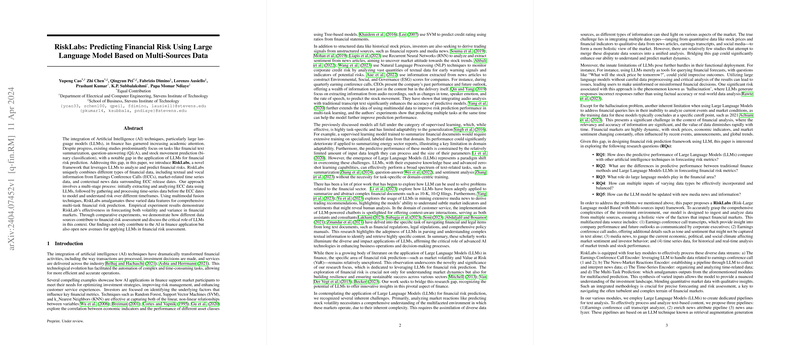Introducing RiskLabs: Enhancing Financial Risk Prediction with LLMs
Overview of RiskLabs Framework
RiskLabs presents a novel approach to financial risk prediction by exploiting the capabilities of LLMs to analyze and integrate diverse types of financial data. The framework stands out for its ability to combine textual and vocal information from Earnings Conference Calls (ECCs), market-related time series data, and contextual news data, through a series of sophisticated encoders and analytic modules. This multi-source, multi-modal fusion technique facilitates a comprehensive financial risk assessment, marking a significant advancement in the application of AI within the domain of finance.
Methodological Contributions
RiskLabs introduces several key methodological innovations:
- Multi-Source Data Integration: By leveraging different types of financial data, RiskLabs achieves a holistic view of the financial landscape, enhancing the accuracy of risk prediction.
- Earnings Conference Call Encoder: Utilizes LLMs to process both audio and textual data from ECCs, extracting salient features that are critical for understanding company performance and market expectations.
- Time-Series Encoder: Adopts a dual approach, incorporating time-series embeddings and a Bayesian-based method to model the relationships among multiple financial metrics, this enhances the prediction of volatility and VaR (Value at Risk) metrics.
- News-Market Reactions Encoder: Employs an enriched news pipeline to assess the impact of financial news on market behaviors, aiding in the prediction of stock movements and market dynamics.
Experimental Evaluation and Findings
RiskLabs was evaluated against several baselines, including classical financial models, LSTM-based models, and other AI-driven approaches. The framework demonstrated superior predictive performance, particularly in volatility forecasting and VaR estimation, as reflected in its lower mean squared error (MSE) across different forecasting intervals. Additionally, an ablation paper revealed the incremental value added by each component of RiskLabs, confirming the efficacy of its integrated approach.
Practical Implications and Theoretical Contributions
The success of RiskLabs underscores the potential of LLMs in financial risk assessment, offering a viable alternative to traditional and existing AI-based models. From a practical standpoint, RiskLabs provides investors and financial analysts with more accurate and comprehensive risk predictions, facilitating better-informed decision-making processes. Theoretically, this work contributes to the growing body of literature on the applicability of LLMs in finance, particularly in addressing the challenges of financial risk prediction.
Future Directions
Building on the current capabilities of RiskLabs, ongoing enhancements focus on refining the News-Market Reactions Encoder and expanding the dataset for a broader validation of the model. The introduction of "Dynamic Moving Time Window" training and "Time Decay Hyper-parameter" settings is anticipated to further improve the timeliness and accuracy of risk predictions. These developments reflect a continuous commitment to advancing the frontiers of using LLMs for financial analysis.
Conclusion
RiskLabs represents a breakthrough in financial risk prediction by effectively harnessing the power of LLMs to process and analyze multimodal financial data. Its comprehensive approach not only advances the state of AI applications in finance but also opens up new avenues for research and innovation in this critical and complex domain.
